The Prince’s Palace in Monaco Is Now Showcasing Recently Uncovered 16th-Century Frescoes

- Oops!Something went wrong.Please try again later.
- Oops!Something went wrong.Please try again later.
Erected in 1191 as a Genoese fortress, the official residence of the Sovereign Prince of Monaco has been the home of the Grimaldi family since 1297. Generations later, in 2015, an unusual discovery was made: the remains of dazzling frescos, featuring the 12 labors of Hercules (as well as his birth and death) and likely dating to the 16th century, were found in the Galerie d’Hercule.
The first order of business was to restore the Galerie d’Hercule, the loggia that you come across as soon as you enter the well-guarded yet lavish fortress that is accessible via a sumptuous double staircase from the 17th century. A picture from 1864 is the only record of what some of these frescoes may have looked like.
In the 19th century, artists Philibert Florence and Jean-Baptiste Carbillé—working separately on the Galerie’s vaults and lunettes, respectively—were likely the first to paint over them, creating new frescoes in the same vein as the originals. Then, in 1962, Mauro Pellicioli and Leone Lorenzetti had the intention of undoing their predecessors’ work and restoring the frescoes, but they ended up creating new murals instead. Each restoration ended up impoverishing the previous one.
The newest restoration, unveiled earlier this year and open until October 15, is at the heart of a refreshed Palais de Monaco, which also included a restoration of Prince Albert II’s apartments and an entire rethinking of the palace. The apartments reopened to the public in April, as the restoration of some rooms continue. One significant change is how visitors enter and exit the palace. Instead of touring from one side of the residence to the other, they will now enter through the central door that leads from the Galerie d’Hercule into the Chambre d’Europe and into the rest of palace. The palace’s rooms have also been recently renamed in reference to their 16th-century iconography.
Click here to read the full article.
Seven of the thirteen original frescoes were uncovered under just the layers of paint dating to the ’60s. For the conservators, the question became how to harmonize the façade, especially since today’s standards require that any intervention be reversible.
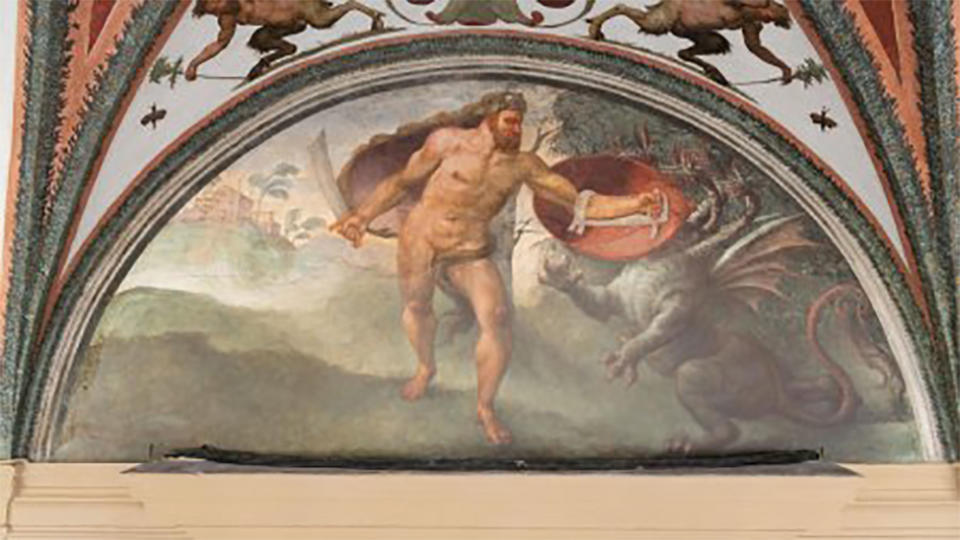
In the places where no original frescoes remain, the painting was done on removable aluminum panels. Over the past eight years, the restoration team has developed 14 shades of water-based paint, the results of numerous tests to ensure that these tones would be compatible with the frescoes’ mineral foundation. (The formula includes pigments crushed with gum arabic and binding elements with vegetable glycerin.)
The subtle differences between old and new are noticeable to keen observers; that’s intentional, according to Marion Jaulin, head of the conservation team: “This way, visitors know exactly what is original and what is not.” (One detail that is worth mentioning is that someone from the Palace’s archives department, who practices combat sports, served as model for Hercules 2.0.)
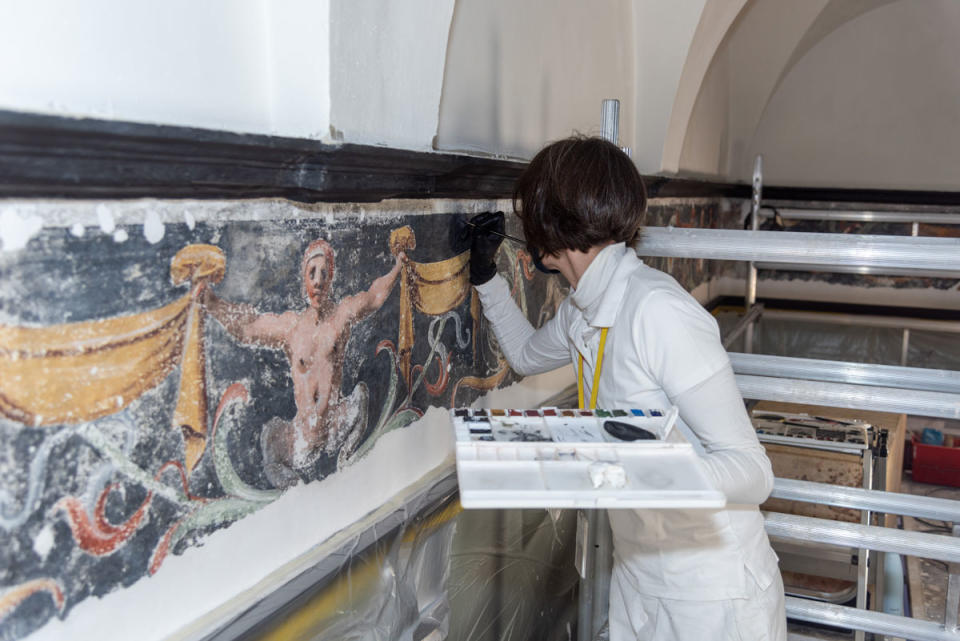
When efforts to restore the Galerie d’Hercule were already underway, the restoration project was extended to include other parts of the palace. In 2016, a chunk of primer fall off the wall in the Chambre d’Europe (then called the Salon Matignon) revealing a swath in green with a red dot at its center, which did not match the Belle Epoque décor of the room.
To uncover what was beneath, the 19th-century layer had to be removed, but this time, restorers decided to preserve around seven of the later fresco’s figures by transferring them onto plaster. (This is a temporary fix until they find a more suitable material to support them). In the middle of the ceiling was a representation of Europa kidnapped by Jupiter in the guise of a bull, though the scene is incomplete. When there were not enough surviving details to complete a scene like this, the restoration team simply highlighted the characters’ contours and colored them with a lighter shade of red than the frieze’s background—a sort of shadow play, according to the team.
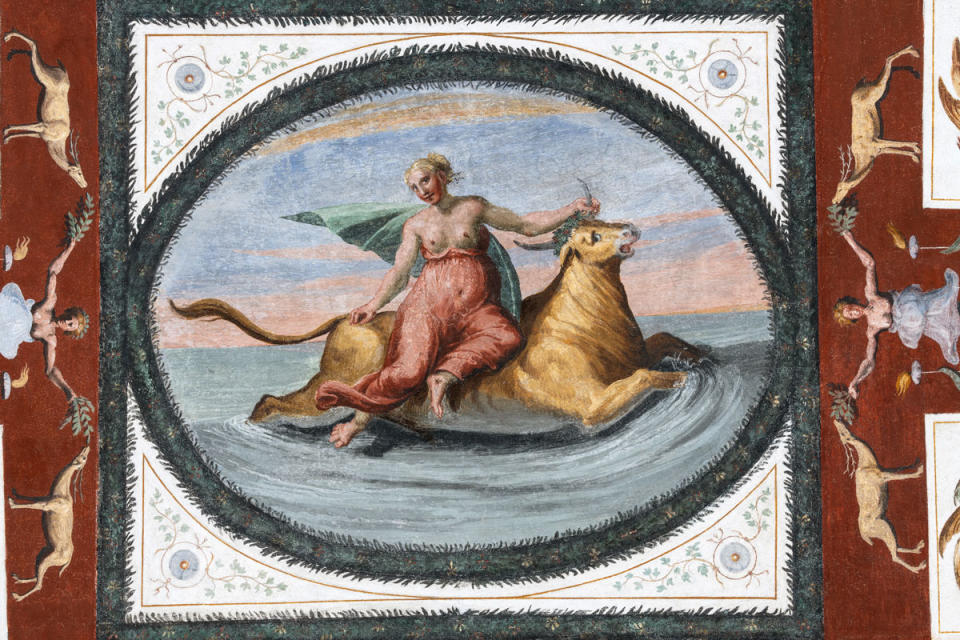
The same approach will probably apply to the Chambre à alcôve de marbre (the former Chambre Louis XIII), devoted to Bellerophon, one of the greatest slayers of monsters in Greek mythology, known for capturing the winged horse Pegasus. At the moment, scaffolds stretch up to the ceiling, as the restoration process, which is estimated to take two years, is still at an early stage. The main concern for the entire project has been to not to confuse overpainting with highlights from the original. (The latter must be preserved, whereas the former should be removed.)
In the same room, which had been divided in two at one point, the Palace’s team discovered an alcove containing yet another 16th-century ceiling—though this one had been hidden, in the 17th century, by a lower ceiling, not an overpainting. Because the surrounding lunettes were redesigned, getting rid of this architectural addition might not be possible, which would be a shame given that the original painting appears to be in perfect condition.
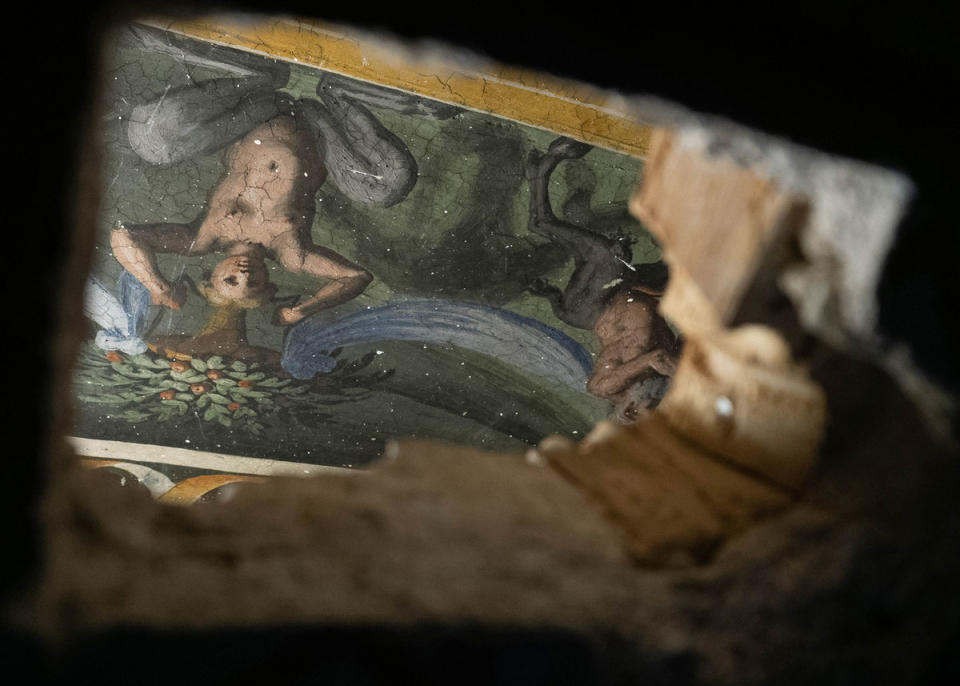
While that restoration continues apace, the main focus is finishing the Salle du Trône by the end of the summer. As with the completed restorations, the technique used here is the trattegio retouch, which entails filling pictorial gaps with vertical lines that, from afar, form a recognizable pattern. Several of the conservators use lasers, which has become an indispensable tool in fresco restoration for it has a less aggressive impact than most chemical products. This laborious process requires dexterity and patience, and the conservators lean on custom-made chairs or poles to support their backs, wrists, or elbows during the long hours. (A chiropractor is regularly summoned to release the stress in their bodies.)
The restoration campaign allowed the Palace’s team to see its building in a new light; that led to them to think about how the art on display throughout the apartments could also be seen in a new light. The Princes of Monaco have always been art lovers, though some of their holdings were scattered around the world after the French Revolution in 1789. About 15 years ago, Prince Albert II decided to recompose the Palace’s collections to their former glory. At first a private endeavor, he eventually agreed to share these recent acquisitions with the public, including The Israelites in the Desert by Jacopo Bassano (1510–1592) and The Assembly of Gods by Orazio de Ferrari (1606–1657), which was attributed at some point to Charles Le Brun and has now returned to its former spot in the Antichambre verte.
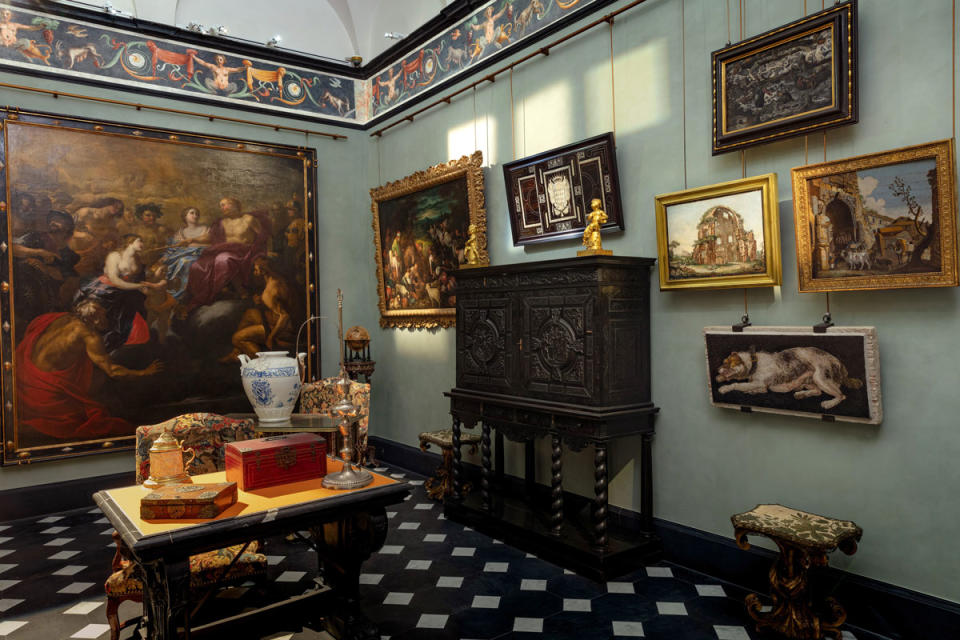
Thomas Fouilleron, the head of the Palace’s archives and library, has led the charge to locate these works, researching their movements via various records like inventories and sales certificates—though some have turned up unexpectedly. “We have located a self-portrait and a portrait of a gentleman by Rembrandt at the Metropolitan Museum of Art in New York, a painting by Fragonard in Los Angeles,” he said. “We are ready for two works by Carlo Maratta to be auctioned again. They are currently part of a private collection in São Paulo.”
Conversely, a painting by David Téniers le Jeune that belonged to Jacques I, the Duke of Valentinois from 1716 until 1733 and the Prince of Monaco from 1731 to 1733, turned up unexpectedly at TEFAF in Maastricht one year. “When we fail to find a missing piece, we replace it in the spirit of the works the collection used to hold,” Fouilleron said. “To get closer to what it used to be like, there is always the option of an exhibition with loans from various institutions.”
Despite its age, the Palais de Monaco is far from withering away. The stunning effect of seeing the restored frescoes in the Galerie d’Hercule lingers as you walk through palace’s brand-new display. The paintings on the walls have been cleaned as though no time had passed. It is especially special to experience as the conservators and curators continue the restoration project, where time collapses and past and present meet.
Best of Robb Report

